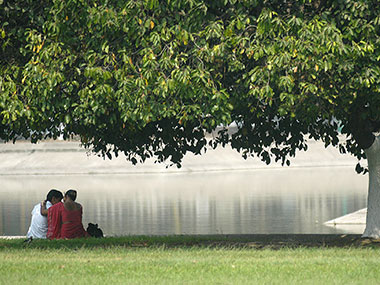Just as reluctant autumn yielded to winter, on a particularly cold evening in Budapest, late 2013, I was up reading for my class the next day. My house and fellow university-mate ensconced herself on the other end of the sofa, sliding her fingers across the screen of her newly bought smartphone. She persevered with that action for the next half hour with no rest. Curious, but mostly tickled and (desperately) seeking distraction from my 80 pages of academic readings, I inquired as to what she was doing. Usually, an excitable person, she grabbed my phone and downloaded this application onto my phone from the play store — Tinder. A tiny icon with an orange flame popped up in my application gallery; she did the rest with incredible ease — under 3 minutes flat, she signed me up and told me how it worked. Then, strait-laced about dating, love etcetera, I found it rather unpalatable — the idea that I could swipe left and right on faces that popped up on my screen from my neighbourhood (or the perimeter I could set on this ingenious application). I swiped once. I swiped twice. I swiped thrice. And since that (un) fortunate night, I have lost many hours to swiping with gusto (and then mostly, lackadaisically) in the pursuit of what I imagined to be something, but can perhaps only be described as, ‘Netflix and chill’.
I will talk about the tiny yet significant percentage of population that is armed with cellphones, tablets and desktops — zooming out, according to Internet World Stats , about thirty percent of the world i.e. of 7 billion people are online. Zooming in, Asia accounts for the largest population of users and in that last 15 years, has seen a growth of 1,319 percent users. According to We Are Social , India has about 350 million active internet users. Around 289 million active users are from the urban areas and a significant portion of those users access the internet on their mobile devices. As far as the dating game is concerned, close to 6 million singles in India have joined dating sites, according to Dating Site Reviews , it’s a market worth $130 million (and growing). In 2009, the popular Date.com was offered as a free service in India. CEO, Meir Strahlberg said in a statement , that the “new generation, which is wired and technologically advanced, is embracing online dating as opposed to working with matchmakers.” Vivienne Diane Neal, in Making Dollars and Cents Out of Online Dating uses data from Juniper Research saying that India and Japan are one of the biggest markets in online dating.
According to a Tinder spokesperson, 14 million swipes happen each day in India — an increase from 7.5 million in September 2015 and as you’re reading this, a man with brown hair wearing a flannel shirt, khaki pants and a thick beard is probably logging on to a dating application. So is this other man who just got back home from his long tiring day…Oh! And this woman who loves dogs is perhaps typing in her likes and dislikes on an online dating website. The urban Indian demographic has taken to the tools of finding love (or at least finding consensual, casual sex) online.
This, however is not a unique metropolitan experience — it is not just men, women, girls and boys from Mumbai, New Delhi, Bengaluru or Chennai who are plugged in to look for their significant others , but also a significantly young demographic (18-21 years) who are flirting with the concept of meeting someone online for the explicit purpose of dating. Sachin Bhatia, CEO of Truly Madly calls his app a “janta or mass market product” — a significant portion of the users (45 percent) on Truly Madly are from non-metropolitan cities. “It is not your typical iOS South Bombay crowd, though we have some of those too,” he says.
The grammar and syntax of dating is changing. Online dating has lost a lot of the (perceived) stigma that it used to have. Varun and Alisha met on Tinder and got married. “We got onto the app because we were very curious, all our friends were on it and they kept talking about it,” says Alisha, while her husband dutifully agrees. No one really cares about where you met your significant others, at least not in the big cities, and people from smaller cities seem to be following suit. Bhatia of Truly Madly, confirms that many of the application’s early adopters were “girls from smaller towns who moved to bigger cities to work or study, since their social circles were limited to their campus or office.”
Picture this — a Friday evening, the pub is getting cozier, men and women are trickling in. Most heads are looking down into a screen, every once in awhile, they look up, smile and converse with their friends before they go back to tapping pixels on their phones. In one part of the pub, that is now getting louder with painfully popular Justin Bieber songs, a group of men are discussing their latest ‘sexcapades’ — how many women they met and how many women they eventually undressed. In another group that includes both men and women, a woman laments about the futility of it all — getting dressed, going on dates, sometimes having sex and then getting disappointed — all that effort is going nowhere.
Avinash Shah* (29) is a film studies professor, he has matched with a number of women on Tinder but says that he is only in it for the hook ups. “Sex with no strings attached, is what I prefer. It has become so easy now. Women do not judge me, I do not judge them. We have a good time and then move on. Some remain as friends,” he says. “Tinder is like a cold lead, both the parties should be interested in it for it to get converted into a sale,” says Nitesh Rao (29). Nitesh and Avinash, both claim their original intention is to find love, not get laid. So, what is it that’s holding them back? Apparently, a lack of authenticity and uniqueness — a feeling shared by almost all the 20 men I spoke to for this article. Varun and Alisha, the successful Tinder couple also expressed that their social circles were limited and that they were looking for something unique. One of Alisha’s pictures was taken in an off-beat track in Himachal Pradesh, Varun had been there on a trek and that became his way into Alicia’s life. “I was very intrigued that she had gone to this strange place that not many have been to, I realised that perhaps she is adventurous like me, I thought it was something special,” says Varun.
Nitesh met with seven girls out of the ten he matched with this month and slept with four of them. Anil Rathore* (25) works for a film production company in Mumbai, he says he has gone from wanting the one to not wanting any kind of serious commitment. “Relationships can be stressful, I want something non-committal. Strangely, I also want variety. I’d like to meet different girls. It’s nice to meet new people, all kinds of people, that you may not meet otherwise. That’s what I like about it. Sometimes you get romantically involved, sexually involved, sometimes you become friends, sometimes you don’t even meet.”
Nancy Jo Sales in her article (that almost broke the Internet) titled, Tinder and the Dawn of the “Dating Apocalype writes quite elaborately as to how, perhaps, the unlimited pool of interest out there is killing love, softly, one swipe at a time — a point that Aziz Ansari also raises in his extensively researched, yet extremely humourous Modern Romance ; he writes:
“Now, look at my generation. We’re in a hallway with millions of doors. That’s a lot of doors. It’s nice to have all those options.
But—a hallway with millions of doors? Is that better? Is it terrifying?”
“I think we are all hyperlinked. When we are looking for love, we have multiple tabs open. It is almost as if we don’t know what we’re chasing, but we like to believe that we know exactly what we want. This is all possible while we’re with someone. Honestly, when I am with a girl on a date, I am thinking what else is out there for me. It’s problematic, I agree, but it’s addictive,” shares Siddhanth Sharma* (22), an aspiring filmmaker. Rathore also says that online dating fulfills the need for intimacy, romance, sex, fun and excitement. “It’s fulfilling in some way. Whether its long term, for a few months, a few weeks, a night, a dance. What I want varies from time to time.” Rathore has tried OkCupid, Hinge and Truly Madly.
Shruti N.* (21) just graduated and started work at an advertising agency. She has taken on to Truly Madly and Tinder quite seriously. By the end of our brief chat at a busy cafe in Mumbai, Shruti told me she had just finalised a date for the evening. “I am enjoying my body and my freedom. I work very hard and I love that I can meet guys my age. Sometimes, even if it’s just for a hook-up. I like that I can make my own rules,” she says. Sanjana Mitra* (31), content writer puts it out straight, “I like wining and dining and if it is followed by sex that I want, great. If not, I move on to the next unique thing that is out there. I want to find love, yes. In the meantime, this is great,” she says. Ashraya Yadav* (26) in the last week went on four dates, slept with two and is now deciding if she wants to take anything forward. This seems to accurately describe Ansari’s point about “the experience of being a young, unencumbered, single woman.”
Emerging adulthood: Swipe right, swipe left. Repeat
Online dating portals and applications are now commonly used by most urban (also semi-urban) men and women — yes, the kind with first world problems. Sahil Thaker writes in Dating and Marriage Diaries in Urban India that owing to sharp changes in family dynamics (decrease in the number of joint families), a large number of women become independent at an early age, move out of their homes to bigger cities, jobs which bring in changes in their lifestyle.
Going by the numbers, Truly Madly has about 2 million downloads with 1,00,000 active users, who on average spend 42 minutes per day on the app in about eight to ten sessions. Users range between 18-21 and 22-26 comprise 40 percent. Most of these users work in technology, media and law. Sociologists (and social anthropologists) have observed that there exists an age after school and before “settling down” that they now call “emerging adulthood”; Jeffery Jensen Arnett says that it is an age for exploring one’s identity — what do we truly want from our lives? And emerging adults decide on what to do, whom to be with before being constrained by marriage or a long-track career. I argue that the urban emerging adult (loosely between 18-32) is in this emerging adulthood stage, looking for love (or the idea of it), but is getting sex or the prospect of it and therefore the immediately available gratification is taking centre-stage. Going by Anthony Giddens, British sociologist particularly known for his overview of modern societies and modernity, says that modernity “confronts the individual with a complex diversity of choices…at the same time offers little help as to which options should be selected.” ( Modernity and Self Identity )
Able Joseph, founder, Aisle, espouses the idea that somewhere down the line there might be a large number of people who will perhaps remain single, because there simply is too much (through too many applications) to choose from — choosing one might not be an option.
India Inc. and what lies ahead
India Inc. is obviously not blind or deaf to these statistics; in the last few years, a new crop of dating websites with or without desi tweaks have emerged. Homegrown ones include Aisle (desktop and app) — niche, because the people at Aisle need to ‘approve’ your application before they allow you into their exclusive circle. You answer a series of questions, phone number, email and must link to a social media account (Facebook/LinkedIn), after which they take a few days to decide if you’re worthy.
The focus on most Indian dating apps is also on authenticity/safety — by way of verification, users get to “complete” their profiles and increase trustworthiness by submitting offline ids such as passports etc.
Safety seems to be the greatest limitation that these apps are perhaps trying to overcome. Roundhop.com, an online speed dating website is the latest to tap into this emerging market; currently in it’s pre-launch, the website already has about 400 hundred registered users. Founder, Roundhop, Dhatraditya Jonnavittula says anonymity lets people behave at their “absolute worst”. Jonnavittula sees video-chatting as the future for online dating where verified profiles can use video-calling services to ‘find love’ or whatever it is that they are seeking. Aisle has tackled the safety aspect by including a stringent ‘background check’ and making the entry restrictive.
While there is not much specific quantitative data available on the dating game numbers, it is clear that men and women want to take control of their own lives, it seems like the next step in their bid to create their own identities — this cuts through the ‘small town’ integuement where most online ‘dating’ would mean a marriage arranged through online matrimonial websites. And in these very boxed — but slightly customisable dating applications, men and women are writing/creating their own subjectivities.
*Names changed upon request


)




)
)
)
)
)
)
)
)